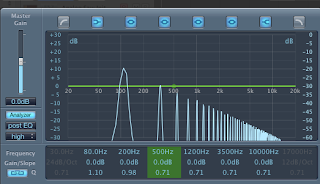Friday, 18 May 2012
ES2: Part II - Filter, Distortion, Phase, Chorus etc.
The second part in the series of videos exploring ES2 synth in Logic Pro 9.
ES2: Part I - Oscillators, Mixer, Tuners and Voice Modes
Here is the first part of my video series explaining the functions of ES2 Hybrid Synth located in Logic Pro 9.
Thursday, 17 May 2012
The Harmonic Series and Basic Waveforms
Harmonic Series
A sine wave is an
example of a pure tone; it is at a fixed frequency but doesn’t contain any of
the harmonic series. A guitar
though would contain elements of the harmonic series and would be determined as
of the pitch that is being played.
In fact any pitched instrument will contain harmonics. The harmonics are essentially placed at equal intervals in
terms of frequency from the pitched tone. The harmonics of an A at 110hz
(above) (first harmonic) would be 220hz (2nd harmonic), 330hz (3rd),
440hz (4th) etc. The
placement of these harmonics is at an interval equal to the main tone. The amplitude of the harmonics will
determine the timbre of the sound and also the shape of the sound wave.
Basic sound wave
shapes
The harmonics present
in a sound wave can determine its shape.
The sine wave is the purest tone so will act as a pure sound wave does;
a perfect wave.
The triangle wave
contains harmonics at an interval of every odd harmonic. So the first, third, fifth etc.
harmonics will be present.
The square wave is essentially the same as the triangle but its harmonics are higher in amplitude.
The square wave is essentially the same as the triangle but its harmonics are higher in amplitude.
Finally the sawtooth
wave contains all of the harmonics series, which essentially stretches the
appearance of the wave to resemble a saw blade.
Here is an example of
all four waves’ appearance.[1]
Subscribe to:
Comments (Atom)





